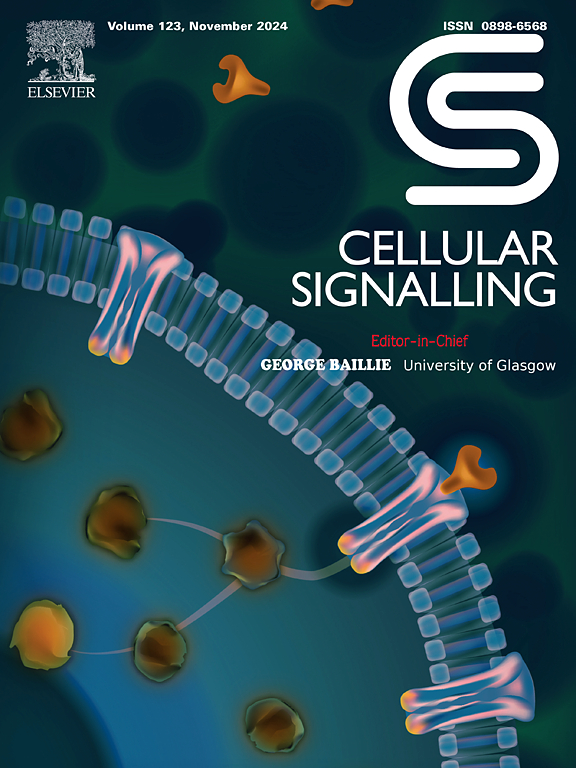ISG15 increases the apoptosis of β cells in type 1 diabetes
IF 4.4
2区 生物学
Q2 CELL BIOLOGY
引用次数: 0
Abstract
Type 1 diabetes (T1D) is an autoimmune disease characterized by hyperglycemia caused by the destruction of insulin-producing β cells. Viral infection is an important environmental factor which is associated with the islet autoimmunity in genetically susceptible individuals. Loss of β-cells and triggering of insulitis following viral infection could result from several non-exclusive mechanisms. Despite a significant increase in ISG15 levels following viral infection, the specific role of ISG15 in the impairment of insulin-producing β-cells is unclear. To address this issue at the clinical level, we conducted this experimental work, and found elevated levels of ISG15 in the peripheral blood of T1D patients, suggesting a potential link between ISG15 and T1D. In the T1D animal model, we discovered that both ISG15 levels and cellular apoptosis were increased in pancreatic islet tissue. To investigate at the cellular level, we cultured MIN6 cells in the presence of supernatants derived from iBMDM cells transfected with poly(I:C) (PIC), a viral mimic. This exposure led to an upregulation of ISG15 expression in MIN6 cells, which was accompanied by the suppression of their functional capabilities and viability. Intriguingly, the direct transfection of MIN6 cells with PIC increased the expression of ISG15. We further found that elevated levels of ISG15 had a direct inhibitory effect on insulin secretion and it also contributed to β-cell apoptosis in a TNF-α-dependent manner. In conclusion, our study revealed a potential underlying mechanism through which ISG15 increases the apoptosis of β-cells, providing valuable insights that could facilitate the development of T1D treatment strategies.
ISG15增加1型糖尿病β细胞凋亡。
1型糖尿病(T1D)是一种自身免疫性疾病,以产生胰岛素的β细胞被破坏引起高血糖为特征。在遗传易感个体中,病毒感染是与胰岛自身免疫相关的重要环境因素。病毒感染后β细胞的丢失和胰岛素炎的触发可能是由几种非排他性机制引起的。尽管病毒感染后ISG15水平显著升高,但ISG15在胰岛素生成β细胞损伤中的具体作用尚不清楚。为了在临床层面解决这一问题,我们开展了这项实验工作,发现T1D患者外周血中ISG15水平升高,表明ISG15与T1D之间存在潜在联系。在T1D动物模型中,我们发现胰岛组织中ISG15水平升高,细胞凋亡增加。为了在细胞水平上进行研究,我们将MIN6细胞培养在转染了病毒模拟物poly(I:C) (PIC)的iBMDM细胞的上清液中。这种暴露导致MIN6细胞中ISG15表达上调,并伴随其功能能力和生存能力的抑制。有趣的是,直接转染PIC的MIN6细胞增加了ISG15的表达。我们进一步发现,ISG15水平升高对胰岛素分泌有直接抑制作用,并以TNF-α-依赖的方式促进β-细胞凋亡。总之,我们的研究揭示了ISG15增加β-细胞凋亡的潜在机制,为促进T1D治疗策略的发展提供了有价值的见解。
本文章由计算机程序翻译,如有差异,请以英文原文为准。
求助全文
约1分钟内获得全文
求助全文
来源期刊

Cellular signalling
生物-细胞生物学
CiteScore
8.40
自引率
0.00%
发文量
250
审稿时长
27 days
期刊介绍:
Cellular Signalling publishes original research describing fundamental and clinical findings on the mechanisms, actions and structural components of cellular signalling systems in vitro and in vivo.
Cellular Signalling aims at full length research papers defining signalling systems ranging from microorganisms to cells, tissues and higher organisms.
 求助内容:
求助内容: 应助结果提醒方式:
应助结果提醒方式:


